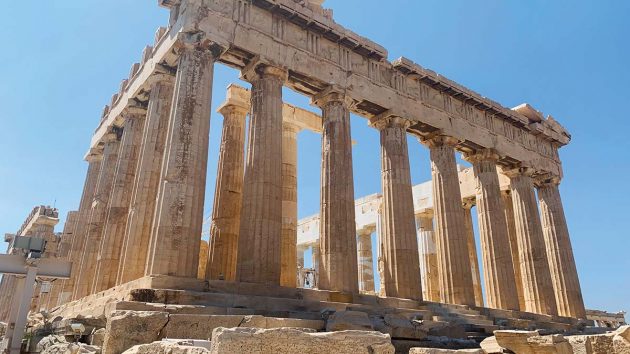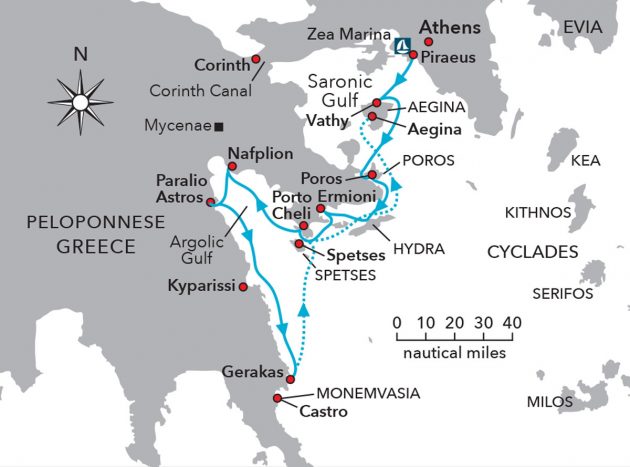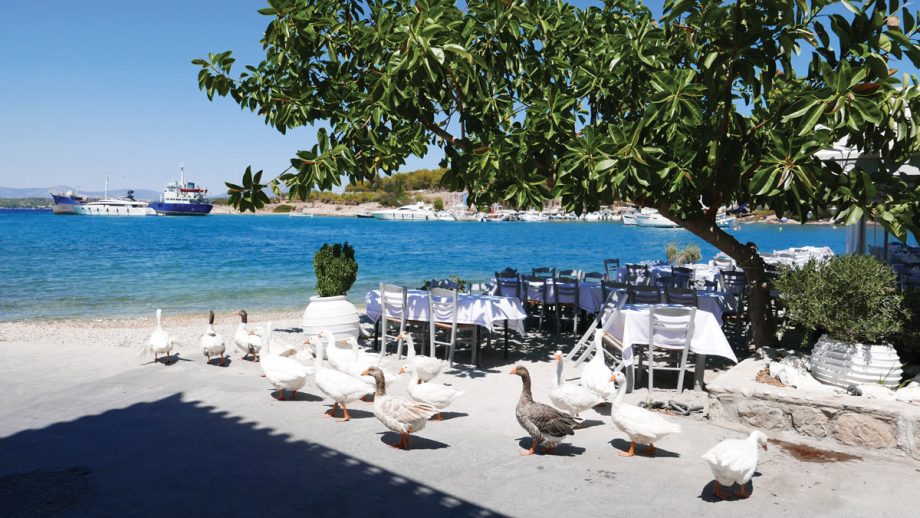In an attempt to escape the relentless Meltemi wind, Thomas and Jutta Kittel take a detour through the more sheltered Saronic Gulf, discovering some hidden gems along the way...
After a brief trip home we are back at Zea Marina in Piraeus, Greece where our Marlow 72, Azura, awaits us. The inner harbour is completely surrounded by apartment blocks but it does mean that shops, restaurants and supermarkets are all within easy walking distance while diesel can be delivered by tanker trucks.
They drive to the quay and then roll out their hoses. However, our need lies in another direction: water. We drink more water than ever before due to the unrelenting heat of 25°C at night and 35°C or more during the day.
We barely feel like leaving the air-conditioned comfort of our trawler yacht but we are in a country with some of the richest cultural history in Europe, so there’s no way we’re going to miss it.
We take the tram from Piraeus to the centre of Athens to visit the Acropolis. The terminus is next to the Greek Parliament building and from there it’s only one stop on the underground metro to the Acropolis.

The Greek Parliament building
The remains of the temples are enthroned on a high rocky plateau, visible from miles around. The ascent is strenuous but manageable thanks to a cooling breeze. The ruins are in varying degrees of condition and crowded with visitors from all over the world, but the view over Athens to the sea is stunning.
It is easy to imagine how in ancient times, visitors were in awe of the people who built such magnificent buildings in this exposed location.

The pair defied the exceptional heat to explore the historic sights in Athens
Wind of change
After enjoying our fill of the ruins and the views, we climb down the steps on the northern edge of the Acropolis leading into the old town.
Suddenly we are in another world. Cosy tavernas, sparsely filled at this time of the afternoon, proactively vie for our custom but we prefer to choose for ourselves – preferably a row or two back where the crowds of tourists rarely get to.

The Acropolis
We settle on a beautiful taverna under the shade of some plane trees with a tempting menu of Greek dishes chalked up on a slate. It’s still too early for dinner but the starters we order are so delicious and plentiful that we leave Taverne Platanos as full as if we’d eaten a three-course meal.
Our original plan, after visiting Athens, was to cruise around the Cyclades and take in some of the well-known islands such as Mykonos, Naxos and Eos. However, by September the notoriously strong Meltemi wind, which blows at a near constant Force 5 to 6, with gusts of 7 or 8, makes things tricky even for seasoned boaters like us.
Since we don’t feel the need to practise our sea survival training, we opt to spend the next few weeks in the Saronic Gulf, southwest of Athens, instead. This region of Greece is new to us and we are excited to explore it.
Article continues below…

Cruising Sicily: Dodging volcanic eruptions on the long journey south

Cruising Campania: Exploring Italy’s south west coastline
Peter Cumberlidge picks out his favourite spots on the Campagnia coastline, from Sorrento to the Bay of Naples and the
After prepping Azura for the onward journey, we set off for Vathy – a tiny port off the beaten track of the local charter operators. As soon as we leave Zea Marina we are met with a strong local wind and current from the north.
We barely cover a few miles westwards before we pick up a May Day call on the VHF radio. Lively radio traffic follows between the distressed vessel, the sea rescue centre and various leisure boats in the vicinity. After the initial panic, it turns out that the stricken vessel has only suffered a steering failure and the emergency system is now working fine.
We aren’t sure a May Day was necessary, but we stay tuned until we’re assured that no further help is needed.

Azura moored stern to the quay in the small but picturesque harbour of Vathi
The virtues of Vathi
Vathi turns out to be an expected gem – a picturesque harbour, very few leisure craft, numerous fishing boats and a handful of tavernas and small guest houses surrounding the harbour basin.
Unlike in larger marinas, the arrival of our 72-footer causes quite a stir. One motorboat is quickly pushed aside to make space for us to drop our anchor and moor stern to the quay. There isn’t much room to lay out a lot of chain but the anchor bites and holds us securely.
Later the harbourmaster arrives and charges us such a small berthing fee that after the rates we’ve become used to in Piraeus, it seems like an error. We spend a wonderful evening in one of the fish restaurants overlooking the harbour, watching the sun dip slowly over the horizon as darkness settles over the scene like a snug blanket.

Houses cling to the hillside at Poros harbour, protecting its waters from the wind
Onwards to Poros
The following day we set sail for Poros, a little further south on the island of the same name. It’s located on the edge of a bay, spreading up the slopes that surround it on all sides and shelter its calm waters. Even from afar, the houses glow invitingly in the sunlight. Boats can anchor in the bay or moor at a seemingly endless pier in town.
A friendly harbourmaster turns on the water and electricity for us and explains how to operate it. Poros is home to a fleet of charter yachts, whose boats we see frequently over the coming days.

Azura berthed in the centre of Poros
Thwarted at Hydra
After two days in this pretty setting, we cruise through the southern entrance of the bay in the direction of Hydra. Long before we arrive we can see several large ships anchored in front of the port. The narrow harbour is completely overcrowded and can only offer us a cramped mooring in front of the outer mole.
To use it, however, you need a long yellow floating stern line, which someone needs to swim or ferry ashore with a dinghy. This line seems to be standard equipment on many boats here but we don’t carry one and even if we did the berth is open to the swell of ferries and taxi boats constantly coming and going.

The harbour at Hydra was completely overcrowed
We decide to postpone our visit until later and look for a suitable daytime anchorage on the north coast of Hydra. Even here the few small coves are full of boats with shore lines, so we give up the idea of anchoring and head for Ermioni instead. Luck is on our side here and we are given the only remaining berth alongside the harbour pier.
There’s a bit of a swell coming in from the east due to the wind, but in the evening the wind dies down and we enjoy the peace and gastronomy of the Greek islands at their best, interrupted only by the occasional hustle and bustle of fast ferries shuttling back and forth to Hydra.
Lost and found
The next morning we take a taxi boat to Hydra and, for a change, enjoy the rapid ride as passengers on the small upper deck. We can hardly believe how busy Hydra is.
Boats, traders, shops and restaurants are all hives of activity and numerous handcarts piled high with suitcases, goods and building materials are being pushed through the narrow, car-free streets.

Thomas and Jutta to seek a quieter spot at Ermioni
When we return to Ermioni in the evening and settle down for dinner in one of the quayside restaurants, the waiter suddenly approaches and asks if we are the people from the blue motor yacht as the police are waiting for me outside.
My initial concern turns to confusion when a young officer asks me if I’m missing anything, which initially I deny. “No camera either?” he asks. The scales fall from my eyes. During an earlier stroll through the harbour, I recall putting my camera on a bollard to help an approaching boat with their lines and apparently forgot to pick it up again.
A boy found the camera, told his mother, who notified the police and handed over the camera. The policeman looked at the photos, saw our ship and tracked us down in the restaurant by word of mouth. Unbelievable – but true!

The Kittels luck out with the only remaining berth on the pier in Ermioni’s charming harbour
The following morning we set off for the island of Spetses, a good hour southwest of Hydra. Smaller and flatter than Hydra, Spetses initially appears unspectacular. The old port is also small and rather ramshackle.
Only a handful of larger yachts can moor alongside the short pier so most end up anchoring in front of the harbour with stern lines to the shore. We decide to drop anchor in the nearby bay of Porto Cheli and visit Spetses by tender.
The town is extremely pretty with numerous beautifully maintained buildings dripping with flowers. At its heart is the splendid church of St. Nikolas, shining like a beacon with freshly whitewashed walls.
Porto Cheli and Navplion
After a refreshing home made lemonade at Thea’s café we clamber into the tender for the return journey. Since the wind has shifted, we are now having to push against it so our previous half- hour trip takes more than an hour. It’s worth it for the wonderful views and near 360° protection afforded by anchoring in the bay of Porto Cheli.
We cannot, however, recommend the modern marina there for visiting craft. Twice we call in there, first with our yacht and in the evening with our dinghy, and both times we are turned away. When we do find a spot to leave our dinghy, the village, which had looked quite promising from a distance, fails to impress on closer inspection.
So the next day we weigh anchor and carry on to Navplion at the northern end of the Argolic Gulf. Our port guide still praises Navplion as a kind of secret hideaway but the number of visiting boats, tourists and restaurants soon prove that word has spread quickly.

To be fair, Navplion is extremely attractive and is best known for its three historic fortresses: Akronafplia on a hill directly above the old town; Palamidi built by the Venetians in 1711 to the east of town; and Bourtzi on a small island in front of the port entrance.
From 1829 to 1834, Navplion was also the capital of Greece before Athens took on the role in 1834. In Navplion, we hire a car and visit the historical site of Mycenae, whose origins date back to 1,500 BC. The midday heat is stultifying but the ruins and museum are well worth the effort.
Then we pay another visit to the Corinth Canal, which we passed through a few weeks earlier, so we can admire the perspective from above. From here we can really appreciate what an achievement it must have been to hew a channel, some of which is more than 80m deep, through solid rock.
On the way back we visit the remains of the amphitheatre at Argos, which once held 20,000 spectators. After so much history, we allow ourselves a breather and head for the small seaside resort of Paralio Astros.
Since the harbour is completely full, we anchor directly in front of it and take the dinghy to town, where Jutta and I spend another magical evening by the water under the open sky. Next, our course takes us further south towards Kyparissi.

Despite a tricky entry, Gerakas proved a perfect port of call
However, once there, a persistent swell from the north-east puts us off staying so we cruise a little further on and call at the small port of Gerakas. This involves entering a short bay surrounded by steep cliffs from the north before executing a 90° turn to starboard into the small port.
Even here the rock walls reflect the incoming swell, causing a persistent roll. Despite this, the harbour is exactly to our liking: nicely situated, safe and with a selection of tavernas on our doorstep.
Only a handful of visiting boats find their way here but the shelter it offers and its proximity to Monemvasia (25km by taxi) make it an attractive option for us.

Red-tiled roofs at Monemvasia contrast sharply with the inky waters of the Med
Astounding Castro
Monemvasia is a huge, craggy outcrop, a bit like Ayers Rock, but surrounded by sea. On the south-eastern side of the rock lies the historic town of Castro, further reinforced by high stone walls with battlements, making it almost impregnable from attack.
The place is stunning and a major tourist attraction. It feels like we are walking through a living museum with tastefully restored houses, alleys, stairs and countless photo opportunities.
As we set sail from Gerakas, heading back north again, the wind freshens up. Although we are cruising relatively slowly at 7-8 knots, the wind throws salty spray over the entire boat, leaving a sticky residue on everything it touches.

Mooring in front of the harbour at Spetses
The expected leeward shelter from the islands of Spetses and Hydra only kicks in very late as we approach the anchorage at Porto Cheli once more. The next morning the wind is still blowing and we stomp across the waves to the island of Aigina, which is only partly under the protection of the mountains.
The small harbour is already rammed with boats packed in cheek by jowl so we anchor in front of the pier and lower our dinghy. We not only go to Aigina but explore the whole bay and its islands, taking in Skala, Angistri, Metopi and the pretty little port of Perdika.
Then it’s time to say goodbye to the Saronic Gulf, which has proved a fitting chapter to our Greek odyssey, not only for the good protection it offered against the Meltemi but also for the many beautiful towns, harbours, bays and islands that make this area such an attractive cruising proposition.
Just when we need it, a weather window opens up, offering us respite from the Meltemi and allowing us to head back out into the open sea. And so, before the end of this year’s trip to Greece, we head towards the Northern Sporades where Azura will explore another beautiful set of islands with a completely unique character.
First published in the November 2023 issue of MBY – download the full PDF here (1MB).

A historic ship dwarfs Poros harbour

A wreck tarnishes the idyllic scenery in Poros

Bustling scenes on a day trip to Hydra

Sampling the local Greek produce during a picnic aboard Azura

Traditional Greek church at Ermioni

Idyllic Spetses











